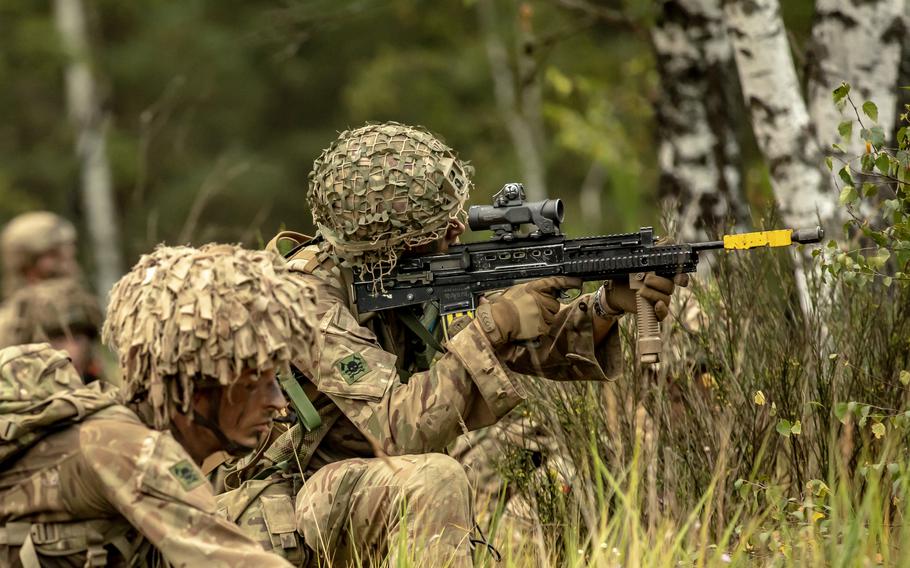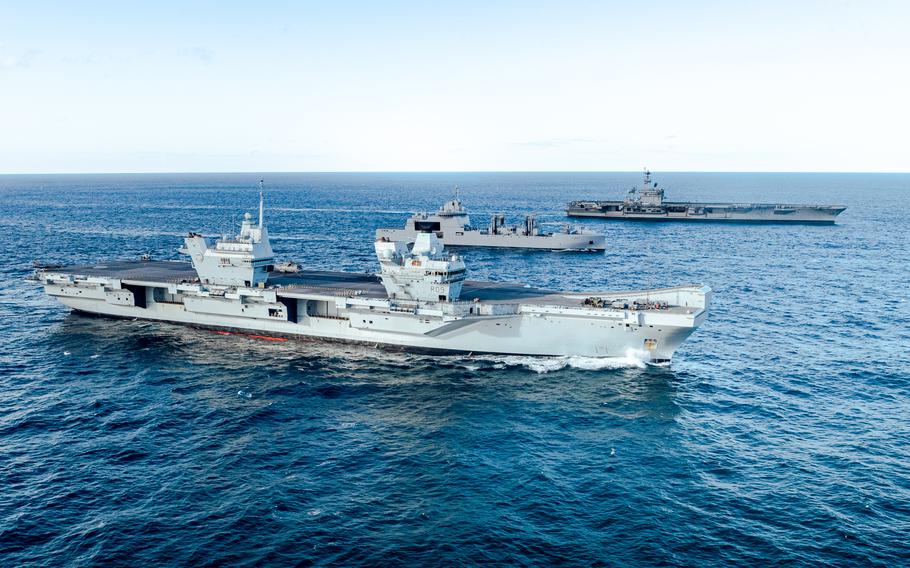
British soldiers secure an area during an exercise at Bemowo Piskie Training Area in Poland in August 2023. This year, the U.K. will send 20,000 troops to Steadfast Defender, NATO’s largest combat drill since the Cold War, British Defense Secretary Grant Shapps announced Jan. 16, 2024. (Alex Soliday/U.S. Army)
The United Kingdom will soon dispatch 20,000 troops to an exercise bringing together thousands of American and other allied militaries for maneuvers across Europe, making it NATO’s largest combat drill since the Cold War.
British Defense Secretary Grant Shapps on Monday announced the U.K.’s contribution to exercise Steadfast Defender, saying it is about sending a message of deterrence at a time of security upheaval on the Continent.
“Battle lines are being redrawn,” Shapps said in a statement. “The tanks are literally on Ukraine’s lawn. And the foundations of the world order are being shaken to their core. We stand at a crossroads.”
Steadfast Defender, which will run from February to June, is expected to serve as a testing ground for new NATO defense plans designed to counter the threat posed by Russia.
The U.S. has yet to announce which of its units will join in Steadfast Defender, but the diverse array of British forces that will take part offers insight into the scale of the upcoming war game.
The Royal Air Force’s most modern fighter jets and surveillance aircraft, along with Royal Navy warships and submarines and a full range of ground forces, are among the elements to be deployed, the Defense Ministry said.
The exercise is part of a broader push by NATO to be more maneuverable in light of Russia’s full-scale attack on Ukraine in February 2022.

The British aircraft carrier Prince of Wales sails with USS George Washington and French logistics supply ship Jacques Chevallier in the Atlantic Ocean in November 2023. Britain will have 20,000 in this year's exercise Steadfast Defender, NATO’s largest combat drill since the Cold War, according to the country's defense minister. (Nicholas Russell/U.S. Navy)
For example, in 2023 the Germany-led Air Defender exercise was billed as the largest exhibition of NATO air power in more than 70 years, involving hundreds of aircraft from more than 20 countries.
In the case of Steadfast Defender, more than 40,000 troops from across the 31-nation alliance will take part. Training locations include the Baltics, Poland and Germany.
In Europe and the U.S., there is widespread debate about the implications of the Russia-Ukraine war for security on the Continent and beyond.
Last week in the Lithuanian capital of Vilnius, Ukrainian President Volodymyr Zelenskyy said at a news conference that if Russian President Vladimir Putin prevails against his country, then Lithuania, Latvia, Estonia and Moldova may be next.
U.S. President Joe Biden has made similar arguments to justify continued support for Ukraine, which has relied on Western arms to defend itself against Russia.
“If we don’t stop Putin’s appetite for power and control in Ukraine, he won’t limit himself just to Ukraine,” Biden said in October.
NATO militaries also have been war-gaming what a potential Russian invasion into allied territory could look like.
On Monday, Germany’s Bild newspaper released secret Defense Ministry documents that revealed how Russia could build up its forces in Belarus this year for a possible confrontation with NATO in 2025 at the Suwalki Gap, a corridor that runs along the Polish- Lithuania boarder between Belarus and the Russian military exclave of Kaliningrad.
The territory has long been considered one of NATO’s most vulnerable areas and would be of major concern if a conflict with Russia ever developed.
On Monday, Russian Foreign Ministry spokeswoman Maria Zakharova dismissed the war game scenario reported by Bild as “last year’s horoscope.”